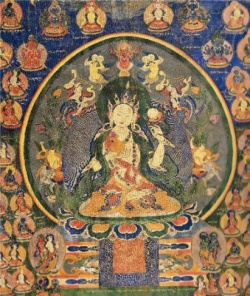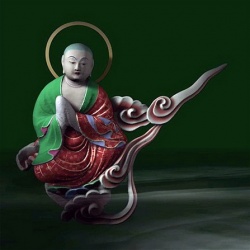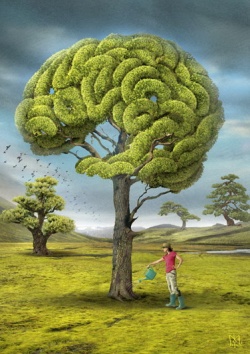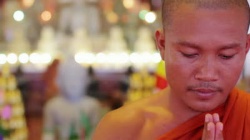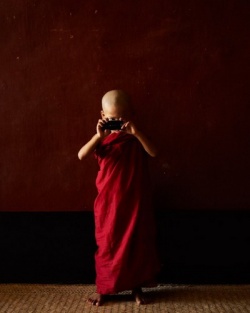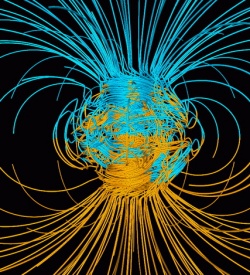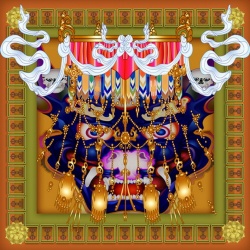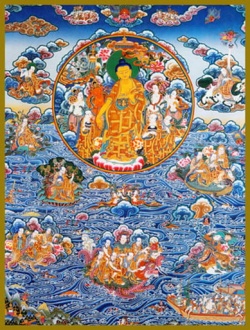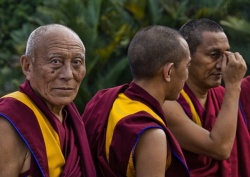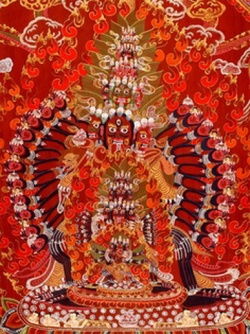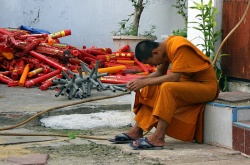Prajnaparamita -The Great Mother
(Devanagari: प्रज्ञापारमिता, Tibetan: ་ཤེས་རབ་ཕ་རོལ་ , Traditional Chinese: 般若波羅蜜多;Simplified Chinese: 般若波罗蜜 多; pinyin: bōrě bōluómìduō; Japanese: 般若波羅蜜多; Korean: 반야파라밀 다; Vietnamese: Bát-nhã-ba-la-mật-đa; Thai: มหาปรัชญาปารมิตาหฤทัยสูตร; Mongolian: Төгөлдөр билгүүн) (2)
The Mother of all the Buddhas, the Great Mother, the figure of Prajnaparamita is referred to by many names and she is seen to be the embodiment of transcendent wisdom. She was not necessarily always seen in anthropomorphic form when the teachings of the Prajnaparamita were originally formulated around 100 BCE.
In Tibet Prajnaparamita is known as Yum Chenmo or the “Great Mother” and features prominently in the Chod dharma system created by one of the most well known yoginis Machik Labdron (approx. 1055-1150ce) who is considered to be an emanation of Yum Chenmo (16).
Jerome Edou quotes Machik's biography in his book Machig Labdron and the foundations of Chod with this description of Yum Chenmo given to Machik Labdron by the Bodhisattva Tara Herself to explain why she manifests in an anthropomorphic manner:
"The Primodial Mother, Yum Chenmo, is the ultimate nature of all phenomenon, emptiness, suchness [Skt. Dharmata), free from the two veils.
She is the pure essence of the sphere of emptiness, the insight on non-self.
She is the matrix that gives birth to all the Buddhas of the three times. However, to give beings the opportunity to accumulate spirtual merits, she manifests as an object of veneration."
Thus have I heard... The Prajnaparamita Sutras
The Buddha was gathered with the sangha of monks and bodhisattvas at vulture peak mountain in Rajagriha.
Shariputra the Buddhas brightest student is taught the Prajnaparamita teachings by Avalokitesvara the Bodhisattva of compassion.
This is the scene depicted in the Heart Sutra(14) linking the historical Buddha to these newer teachings.
The teachings about Prajnaparamita are considered to be The Second Turning of the Wheel of Dharma and the foundation for Mahayana Buddhism.
There are various versions of these Prajnaparamita Sutras which are classified by length: a 100,000 lines, 25,000 lines and 8,000 lines as well as a very popular short version commonly known as the Heart Sutra and is used throughout most Mahayana schools of Buddhism.
Folklore Origins of the Prajnaparamita Sutras
There exists an interesting Tibetan story as to how the heart sutra becomes incorporated into the (Mahayana) Buddhist tradition.
It is said that during the time of the Buddha there were many teachings that the Buddha felt the world was not ready for.
With the hope that one day there would come a time when people would be ready for this information, the manuscripts of these wisdom discourses, including the teachings found in the heart sutra, were given to the serpent king Nagaraja.
Nagaraja kept these teachings in his subterranean realm of the Naga for the years to come.
It was the great monk and teacher Nagarjuna who was chosen to enter this realm and was allowed by Nagaraja to study and meditate on the texts.
Nagarjuna was soon able to bring the information back above the water and allow for its dissemination (19).
While this story is realized by many to be traditional folklore of the origins of the heart sutra it is still an important story.
The importance of the story lies in why the story was created. This story is used to prove the validity of the heart sutra.
The story attempts to do this by showing how the teachings provided by the heart sutra come from the Buddha.
The fact that this sutra comes from the Buddha is a very important one to any Buddhist.
The word of the Buddha holds a great significance to any Buddhist because it is believed that he spoke the Dharma.
Therefore, by tying this text to the Buddha a practitioner of this faith finds authority and validity in its meaning.
This method of showing a religious text to be valid is not unique to the Buddhist tradition. For example, the Bible is said to have been the word of the Lord.
This assertion is intended to show that the teachings that are found within the Bible come from a higher religious authority, in this case God.
Emptiness also is Form: Prajnaparamita Personified
The term Prajnaparamita is generally translated as the perfection (paramita) of wisdom (prajna).
These second turning teachings on the Prajnaparamita not only reiterate the first turning teachings, such as no-self (anatman), but also introduce the concept of emptiness (shunyata) of phenomenon as well.
Emptiness here is not referring to nothingness or voidness but more to a sense of things not existing independently or permanently of any other being or thing. (15)
The Heart Sutra (14) is filled with colorful imagery to illustrate these points in lines such as:
“No eye, no ear, no nose, no tongue, no body, no mind, no appearance.”
From the Mahayana point of view it is from this great emptiness that Bodhichitta, or awakened mind, can arise. A direct understanding of emptiness as the nature of reality leads to enlightenment.
Since this experience of emptiness is the birthplace of the realization of all Buddhas and Bodhisattvas thus Prajnaparamita, the perfect wisdom that sees emptiness, is seen to be the “mother” to all the Buddhas. (16)
When this concept went from being a metaphor to becoming an anthropomorphic bodhisattva is not entirely known.
In the introduction to her book Machik's Complete Explanation Sarah Harding briefly discusses some archeological evidence of early depictions of Prajnaparamita depicted in human form and states:
“Thus we can postulate that the abstract absolute made this leap into the relative world of form sometime between the first appearance of the wisdom literature and the fourth century, using the intermediary springboard of Word (“mother”) as metaphor.” The Unequaled Mantra
The Mantra associated with Prajnaparamita and it is also found in the Heart Sutra is:
"Om Gate Gate Paragate Parasamgate Bodhi Svaha"
Which could be loosly translated as " Gone, Gone, Gone beyond, gone thus beyond, awake, so be it!" (21)
Prajnaparamita Emanates in Tibet
Machick Labdron (approx. 1055-1150ce)
Machik Labdron (Tibetan: མ་གཅིག་ལབ་སྒྲོན་) was an eleventh century Tibetan woman who is believed to be one of the emanations of Yum Chenmo (17).
She was supposedly born with three eyes and skin the color of a "polished conch," which is to say white. (16) Throughout her life she took on several different roles.
She began her dharma life as a reciter of the Prajnaparamita sutras.
She was reportedly exceptionally fast at this and could read the long 100,000 verse Prajnaparamita Sutra in one day and was therefore in high demand (20) as a reader.
She took up a monastic life to avoid the social requirement of marriage which allowed her to devote her life to the dharma. Eventually she concluded her time as a nun when she married her husband Topa Draya.
With her husband Machik she raised several children.
Many of these children are said to have been prominent figures in the Buddhist tradition bases on their devotion and achievements(20). For this reason many praise Machik for the valuable lineage she was able to give to the Buddhist tradition.
Even with the added responsibility of raising a family she was still able to pursue a life devoted to the dharma. This devotion to the dharma eventually blossomed into a new Buddhist practice referred to as Chöd.
Chöd: Ritual practice based on Prajnaparamita
The Dharma system created by Machik Labdron called Chöd is a Vajrayana sadhana practice that features Yum Chenmo at different points throughout the practice, utilizes the Prajnaparamita Mantra, and were the practicioner visualizes,
among other things, chopping up one's own body and feeding it to demons and ghosts to really emphasize non-attachment to self.(16)
Chod is a highly ritualized tantric dharma practice that incorperates elements of the Prajnaparamita philosophy with pre-buddhist Bon Shamanistic practices.(15)
Chod practicioners were historically charnel ground dwelling yogis and yogini's who were known for there outragoues styles of dress, and also like the Prajnaparamita literature, the practice is commonly associated with exorcisms and funerary rituals. (15)
Outwardly the practice utilizes singing, and musical instruments one of which, the Kangling, is made out of a human thigh bone and is played as a trumpet or horn.
The Kangling is used to summon the Demons to come eat the feast of the visualized dismembered body. (16)
This usage of visualization drives home the concept of non-attachment and inherent non-existence to self that is referenced in the Prajnaparamita literature, and further emphasizes the link between the Prajnaparamita philosophy and the practice of Chod.
Prajnamparamita is often depicted as a golden bodied divine figure.
In the forms of Yum Chenmo and Prajnaparamita she is exclusively represented as a female bodied individual which is given away by her breasts rather than any other feature such as face shape or hair length which are ambiguous gender markers in Southern Asian art.
The depiction of Prajnaparamita as a female has a linguistic base in the term Prajna which is a feminine word in Sanskrit (13) similar to the Greek word Sophia meaning wisdom.
Prajnaparamita represented as a female satisfies the internal primal need for reverence toward the divine feminine which has existed in human art since paleolithic times in the form of, for example, the Venus of Wilendorf and also in modern art such as the depiction of the virgin Marry, the Goddess Amarterasu, the Goddess Lakshmi, etc. and other female religious figures.
It may be perceived to be a progressive trend in Mahayana sects to regard females as just as capable of enlightenment as compared to males and Prajnaparamita reflects this trend.
In previous Buddhist thought as well as the thinking of some contemporary sects birth as a female is considered a lesser birth than that of a male but in some Mahayana sects a female birth may not be considered any less noble a birth than that of a male.
She is depicted here with four arms and seated in the Vajra Posture, or cross legged.
Her first two hands are in the meditation mudra, or hand gesture, in which the thumbs touch and the fingers interlace. Her other two arms she holds symbolic ritual objects which represent meaning in the context of the Bodhisattva's attributes.
In her second left hand is a text, specifically The Heart Sutra (3) which represents Transcendent wisdom and the teachings of the Dharma.
In her second right hand is a Vajra (3) scepter which symbolizes the indestructibility or diamond like nature of buddha-mind or enlightened mind.
She is usually depicted with fine silk clothes and a crown of gold embedded with jewels all symbols of royalty.
She is seated atop a lotus blossom, typical of representations of Buddhas and Bodhisattvas however unusually the lotus rides atop a wisp of clouds (somewhat similar to representations of beings in the God realm in Buddhism and Hinduism) perhaps representative of her ethereal nature as a solely personified concept rather than as an historical figure.
The objects at the bottom of this image probably represent offerings to her such as the blossoms at her right and the conch shell to her left.
The offerings reflect the five sense offerings the mirror represents sight, the conch shell filled with incense represents smell, a lute for hearing, fruit for taste, and silk for touch. (18)
The radii coming from her figure represent emanations of wisdom that come from her grace given to her followers.
The halo is a typical clue to denote an enlightened being.
The smaller Buddha above her represents Buddha Shakyamuni; his position above her may be to emphasize his supremacy in Buddhist veneration as well as his status as a fully enlightened being rather than a bodhisattva.
This supremacy should not be thought to be reflective of the supremacy of a male over a female but rather, according to Buddhist conceptions, the supremacy of full buddhahood over bodhisattvahood.
As with all Buddhist images of veneration consecration and puja (veneration) rituals are required to regard the image as worthy of veneration by Buddhists.
These ceremonies in the context of Prajnaparamita are sometimes performed during a full moon (11).
This is interesting in that it may be linked to the perceptions of many ancient societies that there was some connection between a woman's menstrual cycle and the lunar cycle of full moon to new moon (12) both of which take about a month to cycle through.
There are however alternative representations of prajnaparamita, such as being depicted with only two arms, or standing rather than sitting. The Mudra, or hand gesture she displays can also vary from the Meditation mudra to prayer mudra or even turning the wheel of Dharma mudra as well as possibly others.
The above image depicts her with two arms and in the wheel turning hand gesture.
The accouterments she is depicted with can also vary like when she is not holding the Sutra directly in her second left hand there is often a lotus flower that extends from her left hand and holds the text on top of it as seen to the left.
1: http://lh4.ggpht.com/_KHsTVMfsyBY/R604ODH6HGI/AAAAAAAAB0Y/ZmCxcZnHy48/Yumchenmo.jpg
2: http://en.wikipedia.org/wiki/Prajnaparamita
3: http://lhamo.tripod.com/9deity.htm#Prajnaparamita
4: http://www.metmuseum.org/toah/works-of-art/2001.59
6: http://www.asianart.com/exhibitions/nies/17.html
7: http://www.asianart.com/exhibitions/desire/leaves.html
8: http://www.asianart.com/exhibitions/covers/page7.html
9: http://exhibits.denverartmuseum.org/asianart/collection/seasia/seasia_goddess.html
10: http://en.wikipedia.org/wiki/Jayavarman_VII
11: http://www.manchesterbuddhistcentre.org.uk/events/full-moon-puja-to-rajnaparamita.html
12: http://en.wikipedia.org/wiki/Menstration#Nightlighting_and_the_moon
13: http://en.wikipedia.org/wiki/Prajna
14: http://www.openletteronline.com/main/2006/11/the_heart_sutrathe_prajnaparam-print.html
15: Machik Lobdron and the foundations of Chod
16: Machik's Complete Explanation
17: Norbu, Namkhai (1986). The Crystal and the Way of Light. London: Routledge & Kegan Paul. ISBN 0140290848
18: http://books.google.com/books?id=-3804Ud9-4IC&pg=PA27&lpg=PA27&dq="five+sense+offerings"&source=bl&ots=FPHzW0PgEv&sig=F4dNlOtw0Dj6HjGwLFxFtHel0Kc&hl=en&ei=lVW9S6LEJ5O0swPZ56zSAw&sa=X&oi=book_result&ct=result&resnum=1&ved=0CAYQ6AEwAA#v=onepage&q=%22five%20sense%20offerings%22&f=false
19: Stephen Batchelor (2000). Verses From the Center. New York: Riverhead Books.
20: Biography of Machik Labdron
21:http://www.wildmind.org/mantras/figures/gategate
Source
http://cubuddhism.pbworks.com/w/page/24856081/Prajnaparamita-%20The%20Great%20Mother
Articles containing word "Prajñāpāramitā" in title
- A Brief Visualization and Recitation of the Great Mother Prajñāpāramitā by Jamyang Khyentse Chökyi Lodrö
- An Annotated English Translation of Kumārajīva’s Xiaŏpĭn Prajñāpāramitā Sūtra Huifeng Shi
- Aṣṭasāhasrikā-prajñāpāramitā
- Aṣṭasāhasrikā Prajñāpāramitā
- Aṣṭasāhasrikā Prajñāpāramitā Sūtra
- Aṣṭādaśasāhasrikā Prajñāpāramitā
- Bhagavatīprajñāpāramitāhṛdaya
- Caturbhuja-Prajñāpāramitā
- Dvibhuja-Prajñāpāramitā
- Edward Conze: A Call to Reassess the Man and his Contribution to Prajñāpāramitā Studies
- Great Masters of Prajñāpāramitā-yāna
- Haribhadra’s commentary (Abhisamayālaṅkārālokā) on the Story of Sadāprarudita (Ch. 30-31 of Aṣṭasāhasrikā Prajñāpāramitā)
- Kauśika Prajñāpāramitā Sutra
- Kumārajīva and Prajñāpāramitā in China
- Mahā PrajñāpāramitāŚāstra
- Mahāprajñāpāramitā Mañjuśrīparivarta Sūtra
- Mahāprajñāpāramitā Upadeśa
- Mahāprajñāpāramitāśāstra
- Mahāratnakūṭa Sūtra 46. Mañjuśrī Prajñāpāramitā
- One lineage of the Sūtra tradition of Prajñāpāramitā, or Yum Chen mo
- Orality, Authority, and Conservatism in the Prajñāpāramitā Sūtras
- Orsborn 2021 ALT English Translation of the ‘Sadāprarudita Avadāna’ in Kumārajīva’s Xiaŏpĭn Prajñāpāramitā
- Pañcaviṃśati-sāhasrikā Prajñāpāramitā
- Prajñāpāramitā
- Prajñāpāramitā-hŗdaya-sūtra
- Prajñāpāramitā-sañcaya-gātha
- Prajñāpāramitā Hṛdaya
- Prajñāpāramitā Hṛdaya Sutra
- Prajñāpāramitā Literature
- Prajñāpāramitā Mantra
- Prajñāpāramitā Nayasūtra
- Prajñāpāramitā Sutra
- Prajñāpāramitā Sutras
- Prajñāpāramitā Sūtra
- Prajñāpāramitā Sūtras
- Prajñāpāramitā Vajracchedikā Sutra
- Prajñāpāramitā hṛdaya
- Prajñāpāramitā sutra
- Prajñāpāramitā sutras
- Prajñāpāramitā sūtra
- Prajñāpāramitā sūtras
- Prajñāpāramitā प्रज्ञा पारमिता (A short notes on Prajnaparamita)
- Prajñāpāramitāhṛdaya
- Prajñāpāramitāhṛdayasūtra
- Prajñāpāramitāratnaguṇasañcayagāthā
- Prajñāpāramitāstotra
- Prajñāpāramitāsūtras
- Representing Prajñāpāramitā in Tibet and the Indian Himalayas. The iconographic concept in the Temples of Nako, rKyang bu and Zha lu
- Rishushakukyo Prajñāpāramitā Nayasūtra: Daily Tokudo Recitation
- Saptaśatikā Prajñāpāramitā Sūtra
- The Father lineage from Prajñāpāramitā and her teachers, such as Padampa Sangye
- Vajracchedikā Prajñāpāramitā
- Vajracchedikā Prajñāpāramitā Sūtra
- Was there really a Prajñāpāramitā Sūtra in Prakrit?
- Ārya Vajracchedikā Nāma Prajñāpāramitā Mahāyāna Sūtra
- Śata-sāhasrikā Prajñāpāramitā
- Śatasāhasrikā-prajñāpāramitā

